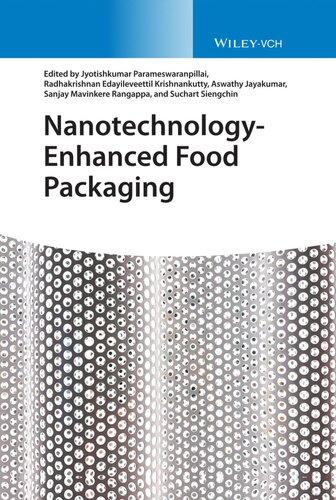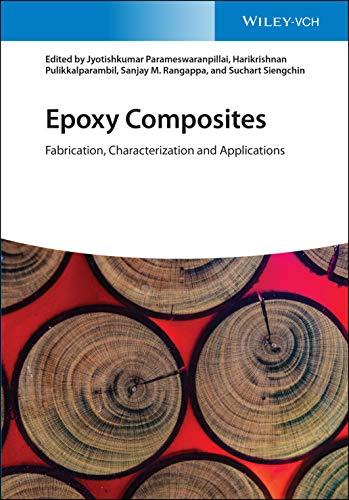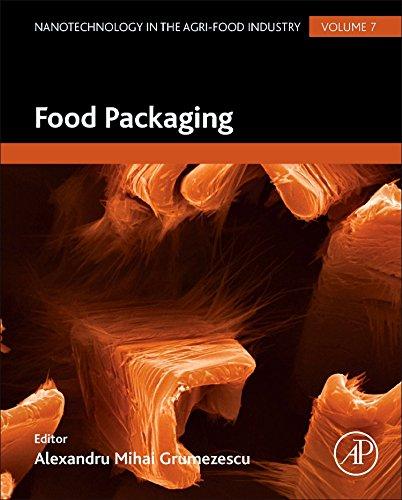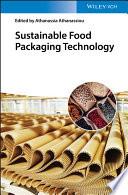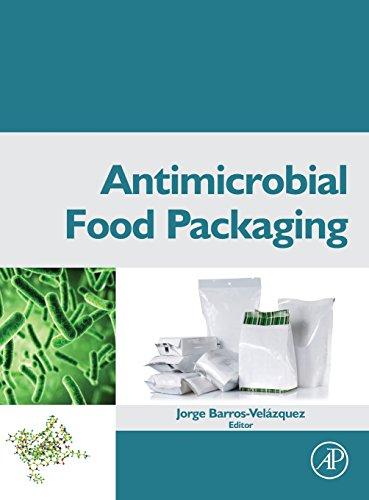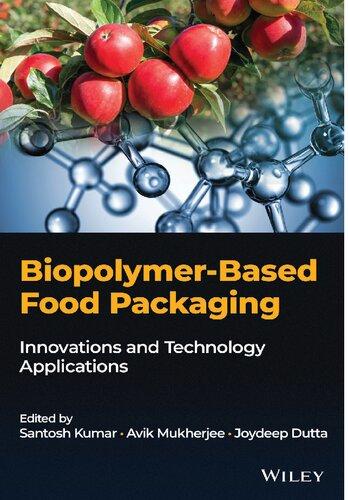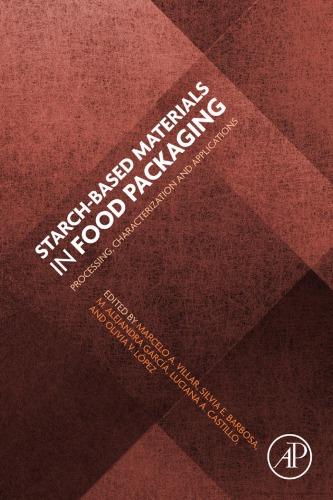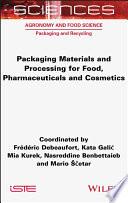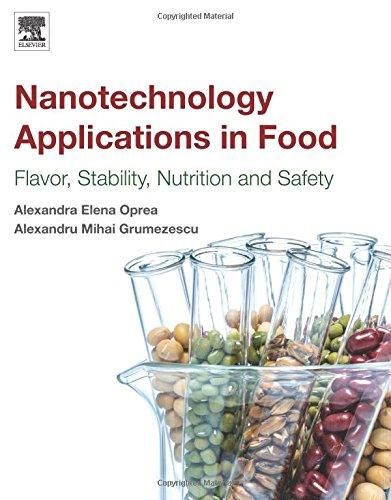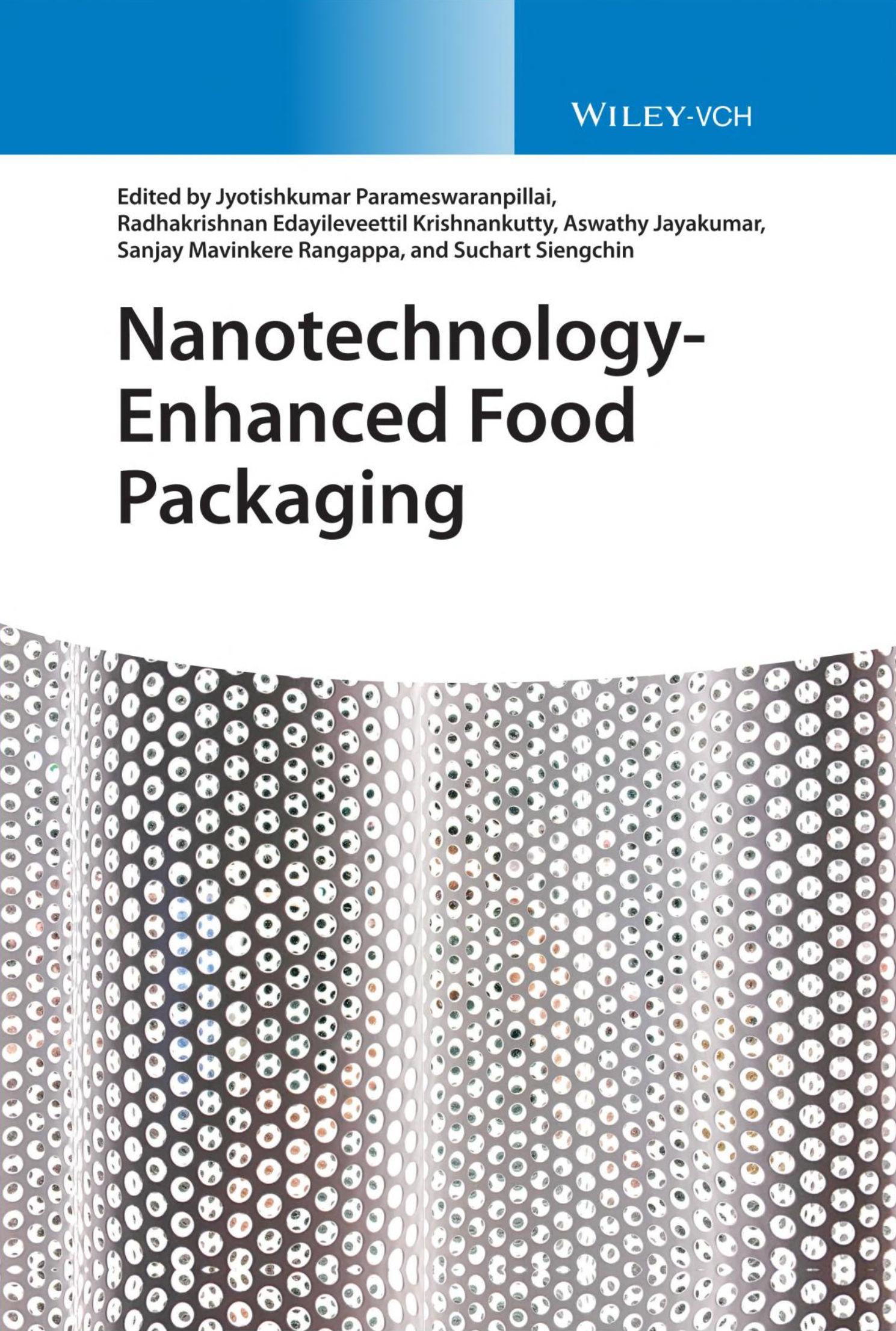Nanotechnology-EnhancedFoodPackaging
Editedby
JyotishkumarParameswaranpillai
RadhakrishnanEdayileveettilKrishnankutty
AswathyJayakumar
SanjayMavinkereRangappa
SuchartSiengchin
Editors
Dr.JyotishkumarParameswaranpillai SchoolofBiosciences,MarAthanasios CollegeforAdvancedStudies Tiruvalla(MACFAST) Pathanamthitta 689101Kerala India
Dr.RadhakrishnanEdayileveettilKrishnankutty MahatmaGandhiUniversity SchoolofBiosciences
P.D.Hills 686560Kottayam,Kerala India
Dr.AswathyJayakumar KingMongkut’sUniversityofTechnology NorthBangkok InnovationinDesignandEngineering 1518Pracharaj1 WongsawangRoad,Bangsue 10800Bangkok
Thailand
Dr.SanjayMavinkereRangappa KingMongkut’sUniversityofTechnology NorthBangkok DepartmentofMaterials&ProductionEngineering 1518Pracharat1 WongsawangRoad,Bangsue 10800Bangkok
Thailand
Prof.Dr.-Ing.habil.SuchartSiengchin KingMongkut’sUniversityofTechnology NorthBangkok DepartmentofMaterials&ProductionEngineering 1518Pracharat1 WongsawangRoad,Bangsue 10800Bangkok
Thailand
CoverImage:©LiyaoXie/GettyImages
Allbookspublishedby WILEY-VCH arecarefully produced.Nevertheless,authors,editors,and publisherdonotwarranttheinformation containedinthesebooks,includingthisbook, tobefreeoferrors.Readersareadvisedtokeep inmindthatstatements,data,illustrations, proceduraldetailsorotheritemsmay inadvertentlybeinaccurate.
LibraryofCongressCardNo.: appliedfor
BritishLibraryCataloguing-in-PublicationData Acataloguerecordforthisbookisavailable fromtheBritishLibrary.
Bibliographicinformationpublishedby theDeutscheNationalbibliothek TheDeutscheNationalbibliotheklists thispublicationintheDeutsche Nationalbibliografie;detailedbibliographic dataareavailableontheInternetat <http://dnb.d-nb.de>
©2022WILEY-VCHGmbH,Boschstraße12, 69469Weinheim
Allrightsreserved(includingthoseof translationintootherlanguages).Nopartof thisbookmaybereproducedinanyform–by photoprinting,microfilm,oranyother means–nortransmittedortranslatedintoa machinelanguagewithoutwrittenpermission fromthepublishers.Registerednames, trademarks,etc.usedinthisbook,even whennotspecificallymarkedassuch,arenot tobeconsideredunprotectedbylaw.
PrintISBN: 978-3-527-34773-5
ePDFISBN: 978-3-527-82770-1
ePubISBN: 978-3-527-82772-5
oBookISBN: 978-3-527-82771-8
Typesetting Straive,Chennai,India
Printedonacid-freepaper
Contents
Preface xv
1IntroductiontoNanotechnology-EnhancedFoodPackaging Industry 1 KunalSingha,BaburajRegubalan,PintuPandit,SubhankarMaity,and ShakeelAhmed
1.1Introduction 1
1.2NanotechnologyApplicationsinFoodProcessing 3
1.2.1NanotechnologyApplicationsinPreservingMeatDensity,Taste,and Presentation 3
1.2.2NanotechnologyApplicationsforMaintainingtheFoodNutrient Value 4
1.3NanotechnologyFunctionsforPreservingorShelfLife 4
1.4NanotechnologyinFoodPackaging 4
1.4.1UsagesofNanosensorsinPathogenandAdulterantDetectioninthe FoodIndustry 6
1.4.2NanotechnologyApplicationsinFoodSafetyIssues 7
1.4.3Bio-BasedNano-packaginginFoodIndustry 8
1.5NanocoatingApplicationsinFoodIndustry 8
1.6NanocoatsUsedinFoodManufacturing 9
1.7ImportanceofNanolamineinFoodBusiness 10
1.8AntimicrobialFilmsUsedinFoodIndustry 10
1.9Nano-scavengingOxygenFilmUsedinFoodorEatingSubstances 11
1.10UV-ProofProcessingofFoodsUsingNanometalOxides 11
1.11Nano-intelligentFoodLabeling 12
1.12Nanotechnology-AidedFreshnessandSpoilageIndicators 12
1.13Nanotechnology-AidedOxygenIndicatorsinFoodIndustry 13
1.14ApplicationofNanotechnologyinProductIdentificationand Anti-counterfeiting 13
1.15UsagesofNanotechnologyinTraceabilityandActiveTagsinFoodand DrugIndustry 13
1.16Conclusions 14 References 14
2AnOverviewofBiopolymersinFoodPackagingSystems 19 JéssicadeMatosFonseca,BetinaL.Koop,ThallesC.Trevisol,Cristiane Capello,AlcileneR.Monteiro,andGermánA.Valencia
2.1Introduction 19
2.2MainPolymersIsolatedfromBiomass 20
2.2.1CaseinandWhey 20
2.2.2CelluloseandDerivatives 22
2.2.3ChitinandChitosan 23
2.2.4CollagenandGelatin 23
2.2.5SoybeanandDerivatives 29
2.2.5.1SoyProtein 29
2.2.5.2SoybeanSolublePolysaccharide 32
2.2.5.3SoybeanFiberandDerivatives 32
2.2.6StarchandDerivatives 35
2.3MainPolymersObtainedbyMicrobialProduction 35
2.4MainBiodegradablePolymersChemicallySynthesized 40
2.5Conclusions 41 ConflictsofInterest 42 Acknowledgments 42 References 42
3NanostructuresBasedonStarch,TheirPreparation, Processing,andApplicationinPackaging 55 CristianC.Villa
3.1Introduction 55
3.1.1StarchNanoparticlesandNanocrystals 55
3.1.2StarchNanomaterialsinFoodPackaging 57
3.1.3StarchNanomaterialsasCarriersofBioactiveMolecules 58
3.1.4PerspectivesandOutlook 59 References 60
4CelluloseNanostructuresandItsApplicationasEffectiveFood PackagingSystems 67 GirilalMandJyothiK.Nair
4.1Introduction 67
4.2SourceofCellulose 68
4.3CelluloseStructure 68
4.4PropertiesofCellulose 70
4.5Nanocellulose 70
4.5.1TypesofNanocellulose 71
4.5.1.1CelluloseNanofibrils 71
4.5.1.2CelluloseNanofibers 72
4.5.1.3CelluloseNanowhiskers 72
4.5.1.4CelluloseNanoballs 72
4.5.1.5CelluloseNanocrystals 72
4.5.2PropertiesofNanocellulose 72
4.5.2.1MechanicalProperties 73
4.5.2.2BarrierProperties 73
4.5.2.3WaterVaporProperties 73
4.5.2.4OtherProperties 73
4.5.3SynthesisofNanocellulose 74
4.5.3.1Electrospinning 74
4.5.3.2Extrusion 76
4.5.3.3Casting 76
4.5.3.4PaperMakingProcessUsingFiltration 76
4.5.3.5CoatingProcess 77
4.6NanocelluloseasPackagingMaterial 77
4.7ComparisonofNanocelluloseandCellulose 81
4.8DisadvantagesofUsingNanocelluloseinFoodPackaging 82
4.9Conclusions 84 References 84
5Chitosan-BasedNanoparticlesandTheirApplicationsinFood Industry 87
BasantE.ElsaiedandAhmedA.Tayel
5.1Introduction 87
5.2Chitosan 88
5.2.1ChitosanPrecursor:ChitinOrigins 88
5.2.1.1TerrestrialSources 88
5.2.1.2AquaticSources 89
5.2.1.3MicrobiologicalSources 89
5.2.2ChemicalCompositionandProperties 90
5.2.2.1StructuralProperties 90
5.2.2.2PhysicochemicalProperties 91
5.2.2.3DiverseProperties 92
5.2.3PreparationMethodsandManufacturing 92
5.2.4ChitosanModifications 93
5.2.5OverviewofChitosanApplications 94
5.2.5.1FoodandBeverageIndustry 94
5.2.5.2Aquaculture 94
5.2.5.3PharmacyandCosmetics 97
5.2.5.4Dentistry 97
5.3NanoformsofChitosan 97
5.3.1ChitosanNanocomposites 97
5.3.2ChitosanNanocarriers 97
5.3.3PreparationMethods 98
5.3.3.1IonicGelationMethod 98
5.3.3.2ReverseMicellarMethod 98
5.3.3.3Emulsion-BasedSolventEvaporationMethod 98
5.3.3.4CoprecipitationMethod 98
5.3.4CharacterizationTechniques 98
5.3.4.1UV–VisibleSpectroscopy(SpectroscopicAnalysis) 98
5.3.4.2ElectronMicroscopy(EM) 99
5.3.4.3DynamicLightScattering(DLS) 99
5.3.4.4ZetaPotential(ZP) 100
5.3.5OverviewofApplications 100
5.3.5.1TissueEngineering 100
5.3.5.2WaterTreatment 100
5.3.5.3Agriculture 100
5.3.5.4DrugDelivery 100
5.4Chitosan-BasedNanoformsApplicationsinFoodIndustry 101
5.4.1OpportunitiesinFoodProcessing 101
5.4.1.1Chitosan-BasedNanoparticles:EnhancingFoodTasteand Appearance 102
5.4.1.2Chitosan-BasedNanoparticles:MaintainingNutritionalValue 103
5.4.2OpportunitiesinFoodPackaging 108
5.4.2.1ChitosanNanoformsFunctionalityasFoodPackagingMaterials 108
5.4.2.2Chitosan-BasedNanoparticlesToxicityandFateinHumanBody 114
5.5UpdatedRegulationsinApplicationofChitosan-BasedNanoparticlesin Food 116 References 117
6Nutrients-BasedNanocarriersandItsApplicationinPackaging Systems 129
LeidyT.Sanchez,N.DavidRodriguez-Marin,MagdaI.Pinzon,and CristianC.Villa
6.1Lipid-BasedNanocarrier 129
6.1.1Nanoemulsions 130
6.1.2Nanoliposomes 130
6.1.3SolidLipidNanoparticles(SLNps) 132
6.1.4NanostructuredLipidCarriers(NLCs) 132
6.2Carbohydrate-BasedNanocarriers 132
6.2.1StarchNanoparticles(SNPs)andNanocrystals(SNCs) 133
6.2.2ChitosanNanoparticles 133
6.2.3AlginateNanoparticles 133
6.3Protein-BasedNanocarriers 134
6.4ApplicationsofNanocarriersinActiveandBioactiveFood Packaging 134
6.5OutlooksandPerspectives 135 References 136
7ActivePackagingSystemsBasedonMetalandMetalOxide Nanoparticles 143 LinaF.Ballesteros,HafsaeLamsaf,SebastianCalderonV,MiguelA. Cerqueira,LorenzoPastrana,andJoséA.Teixeira ListofAbbreviations 143
7.1Introduction 144
7.2MetalandMetalOxideNanoparticlesUsedinActiveFood Packaging 145
7.3MethodsofProductionofMetalandMetalOxideNanoparticles 147
7.3.1PhysicalSynthesis 147
7.3.2ChemicalSynthesis 148
7.3.3BiologicalSynthesis 149
7.4IncorporationofMetalandMetalOxideNanoparticlesintoFood PackagingMaterials 149
7.4.1Extrusion 150
7.4.2Casting 150
7.4.3PhysicalVaporDeposition 151
7.4.4Electrospinning 151
7.5EffectofMetalandMetalOxideNanoparticlesonActivePackaging Properties 152
7.5.1Structure 152
7.5.2Morphology 153
7.5.3MechanicalProperties 155
7.5.4BarrierProperties 156
7.5.5AntimicrobialActivity 157
7.5.5.1SilverNanoparticles 157
7.5.5.2ZincOxideNanoparticles 159
7.5.5.3CopperandCopperOxideNanoparticles 160
7.5.5.4TitaniumDioxideNanoparticles 160
7.5.5.5GoldNanoparticles 161
7.5.5.6OtherNanoparticleSystems 161
7.5.6ScavengerProperties 161
7.5.7PhotocatalyticProperties 162
7.5.8OpticalProperties 163
7.6MigrationofNanoparticles 163
7.6.1FoodSafetyandRegulations 164
7.6.2Regulation 165
7.7EnvironmentalImpactofActiveFoodPackagingMaterials 166
7.7.1Biodegradability 166
7.7.2Recyclability 167
7.7.3LifeCycleAssessment 167
7.8ConclusionsandFutureTrends 168 Acknowledgments 168 References 169
8FabricationofIntelligentPackagingSystemsUsing Nano-IndicatorsandSensors 183 XiutingHuandMingMiao
8.1IntroductionofIntelligentPackaging 183
8.2Nanoparticle-BasedTemperatureIndicators 185
8.2.1SilverNanoparticle-BasedTTI 185
8.2.2GoldNanoparticle-BasedTTIs 187
8.2.3Polydiacetylene/SilicaNanocomposite-BasedTTI 188
8.2.4Nanofiber-BasedTTIs 189
8.3Nanomaterial-BasedHumiditySensors 190
8.3.1ZnONanoparticle-BasedHumiditySensors 190
8.3.2OtherMetallicNanoparticle-BasedHumiditySensors 191
8.3.3PolymericNanocomposite-BasedHumiditySensors 192
8.4Nanomaterial-BasedpHIndicatorsandSensors 193
8.5Nanoparticle-BasedO2 Indicators 195
8.6Nanomaterial-BasedCO2 Sensors 197
8.7Nanomaterial-BasedFreshnessSensors 198
8.7.1FreshnessSensorsBasedonDetectionofBiogenicAmines 199
8.7.2FreshnessSensorsBasedonDetectionofBiogenicSulfides 201
8.7.3FreshnessSensorsBasedonDetectionofATPDegradation Products 202
8.8ConclusionsandPerspectives 205 References 206
9Nanostructure-BasedEdibleCoatingsasaFunctionofFood Preservation 213
AnnaRafaelaC.Braga,JosemarG.OliveiraFilho,AiltonC.Lemes,and MarianaB.Egea
9.1NanotechnologyinFoodPackaging:PrinciplesandApplications 213
9.2EdibleCoatings 215
9.2.1ChemicalCharacteristicsofEdibleCoatings 215
9.2.2MethodstoApplyEdibleCoatings 216
9.2.3MaterialsUsedintheEdibleCoatings 217
9.2.4IncorporationofNanomaterialsinEdibleCoatings 218
9.3SafetyofNanocompositeforApplicationofEdibleCoatings 223
9.4NanotechnologyRegulation 225
9.5FinalConsiderationsandOutlook 227 References 227
10AnOverviewofHigherBarrierPackagingUsing Nanoadditives 235 JohnsyGeorge,BasheerAaliya,KappatV.Sunooj,andRanganathanKumar 10.1Introduction 235
10.2GasandMoisturePermeabilityThroughPolymerPackaging Materials 236
10.2.1PermeabilityofOxygenandCarbonDioxide 237
10.2.2PermeabilityofMoisture 238
10.3NanoadditivesforImprovingBarrierProperties 238
10.4MethodstoPrepareHighBarrierPackagingMaterials 239
10.4.1PolymerNanocomposites 239
10.4.2Coating 240
10.4.3Layer-by-LayerAssembly 240
10.5BarrierImprovementbyReinforcementofPolymerNanocomposites withInorganicNanoadditives 242
10.5.1MetalandMetalOxidesNanomaterials 243
10.5.1.1Zinc 243
10.5.1.2Magnesium 244
10.5.1.3Silica 244
10.5.1.4Titanium 245
10.5.1.5Copper 246
10.5.1.6AluminumOxide 246
10.5.2Nanoclays 246
10.5.3Carbon-BasedNanomaterials 248
10.6BarrierImprovementofBiopolymersbyReinforcementwithOrganic Nanoadditives 249
10.6.1Cellulose 250
10.6.2Starch 252
10.6.3Chitosan 253
10.6.4Zein 253
10.6.5Gelatin 254
10.6.6WheyProteinIsolates 254
10.6.7SoyProteinIsolates 255
10.7Conclusion 255 References 256
11Nanostructure-BasedMultilayerFoodPackagingFilms 265
ShijiMathew
11.1Introduction 265
11.2RequirementsofFoodPackagingSystems 266
11.3MultilayerPackagingFilms 267
11.4StructureandFunctionsofMultilayerFilmPackaging 268
11.5Nanotechnology-BasedMultilayerFilms 269
11.6PreparationofNano-BasedMultilayerFilms 269
11.6.1Layer-by-Layer(LbL)Nanoassembly 270
11.6.2ElectrohydrodynamicProcessing(EHDP) 271
11.6.3MultilayerCoextrusionTechnique 275
11.7PracticalApplicationsofMultilayerFilms/CoatingsforPackagingof Food 276
11.8ConclusionandFutureOutlook 276 References 278
12CharacterizationTechniquesforNanostructuresinFood Packaging 285
AshithaJose,R.Aswani,andRadhakrishnanE.Krishnankutty
12.1Introduction 285
12.2Nanoparticles 286
12.3RoleofNanoparticlesinPackagingApplications 287
12.4NanocompositeinFoodPackaging 288
12.5MethodsfortheDevelopmentofNanocomposites 288
12.6VariousNanoparticlesEmployedinPackaging 289
12.6.1Nanoclay 290
12.6.2TitaniumDioxide 290
12.6.3ZincOxideNanoparticles 291
12.6.4Graphene-BasedNanomaterials 291
12.6.5SilverNanoparticles 292
12.7IssuesAssociatedwiththeNanoparticleIncorporation 292
12.8CharacterizationofNanoparticlesinthePackagingMaterials 293
12.8.1FTIR 294
12.8.2ElectronMicroscopicTechniques 296
12.8.2.1ScanningElectronMicroscopy 296
12.8.2.2TransmissionElectronMicroscopy 297
12.8.3ThermalAnalysisofthePackagingMaterialContaining Nanoparticles 299
12.8.4X-RayPhotoelectronSpectroscopy 300
12.8.5XRD 300
12.8.6ICPMS 301
12.8.7RamanSpectroscopy 302
12.9Conclusions 302 References 302
13BiodegradabilityAssessmentofBiopolymer-BasedFilms 307 AndrelinaMariaPinheiroSantos,BettyDelCarmenJarmaArroyo,Luanade SouzaCavalcanteCarnaval,andEnaydedeAlmeidaMelo
13.1Introduction 307
13.2CommercialandRenewableBiodegradablePolymersand Plasticizers 308
13.2.1ThermoplasticStarch(TPS) 309
13.2.2PolylacticAcid(PLA) 310
13.2.3Polyhydroxyalkanoates(PHAs) 310
13.2.4Plasticizers 311
13.3BiodegradationMechanism 312
13.4BiodegradationofBiopolymerswithAdditives 314
13.5Considerations 316 References 317
14NanobiotechnologyinFoodPreservationandMolecular Perspective 327 S.Agriopoulou,E.Stamatelopoulou,V.Skiada,andT.Varzakas
14.1Introduction 327
14.2NanobiotechnologyAspectsinFoodPreservationandFood Packaging 328
14.3ClassificationofNanomaterialsandMolecularBasisof Application 329
14.3.1Nanoparticles 330
14.3.1.1Silver-BasedNanoparticles 330
14.3.1.2TitaniumDioxide(TiO2 )Nanoparticles 331
14.3.1.3ZincOxide(ZnO)Nanoparticles 331
14.3.2Nanocomposites 331
14.3.2.1Cellulose-BasedNanocomposites 331
14.3.2.2Chitosan-BasedNanocomposites 332
14.3.2.3Protein-DerivedBionanocomposites 332
14.3.2.4PolylacticAcidNanobiocomposites 333
14.3.3Nanoclays 334
14.3.4Nanoemulsions 334
14.3.5Nanosensors 334
14.3.6Nanostructures 337
14.4NanomaterialsandActiveandIntelligentFoodPackaging Applications 338
14.4.1ActivePackaging 338
14.4.2Intelligent(“Smart”)Packaging 339
14.5NanomaterialsandPostharvestQualityParameters 341
14.5.1EdibleCoatingsandFilmsinFoodPackaging 341
14.5.2NanomaterialsandthePotentialagainstPostharvestDiseaseand EthyleneProduction 342
14.6RegulationsandSafetyAspects 345
14.7ConclusionsandOutlook 347 References 347
15EnvironmentalandToxicologicalAspectsofNanostructuresin FoodPackaging 361
SabarishRadoor,JasilaKarayil,JyothiM.Shivanna,AswathyJayakumar, SandhyaA.Varghese,RadhakrishnanE.Krishnankutty,Jyotishkumar Parameswaranpillai,andSuchartSiengchin
15.1Introduction 361
15.2NanoparticlesinFoodPackaging 362
15.2.1Nanoclay 362
15.2.2Nanosilver 362
15.2.3ZincOxide(ZnO)NP 363
15.2.4TitaniumDioxide(TiO2 ) 363
15.2.5SiliconDioxide(SiO2 ) 363
15.3ToxicityMeasurementofNanoparticlesUsedinFoodIndustry 364
15.4Nanotoxicity 365
15.4.1SilverNanoparticles(AgNPs) 365
15.4.2TitaniumNanoparticles(TiO2 NPs) 366
15.4.3SilicaNanoparticle 367
15.4.4ClayNanoparticle 368
xiv Contents
15.5MigrationIssuesofNanoparticles 369
15.6EnvironmentalImpactsofNanoparticles 370
15.7Conclusion 371
Acknowledgments 371 References 371 Index 379
Preface
Theintroductionofnanotechnologyinfoodpackaginghasledtoenormousgrowth inthefoodpackagingindustry.Studieshaveshownthatnanotechnologyinfood packagingcanimprovethequalityandshelflifeoffoodproducts.Theincorporation oforganicandinorganicnanomaterialsintraditionalpackagingmaterialhasgained muchinterestduetotheenhancedthermomechanical,barrier,andantimicrobial properties.Theactivepackagingandintelligent/smartpackagingsystemoffers enhancedfeaturesthatcanextendthequalityandshelflifeoffoodproducts.The activesystemencompassestheincorporationofantimicrobialagents,preservatives, andgasabsorbers,whereastheintelligent/smartsystemuseschemicalsensors, time–temperatureindicators,gassensors,andfreshnessindicators.Theconcerns regardingthetoxicity,risk,andmigrationaspectsofnanoparticlesarealsorising; however,theseassessmentsarenotstillconclusive.
Recently,thereisatremendousincreaseinthenumberofresearcharticlesand patentsinthefieldofnanocomposites.However,onlyafewbookshavebeen publishedintheareaofnanotechnology-enhancedfoodpackaging.Duetothis, webelieveitisbefittingtojudiciouslyeditabookon Nanotechnology-Enhanced FoodPackaging.Thisbookisacollectionofchapterswiththerecentdevelopments innanotechnologicalinnovationsinfoodpackaging.Thechaptersprovidea comprehensivereviewontypesofnanoparticles,theirprocessing,characterization,developmentofnanoparticle-basedpackagingsystems,andapplications.In additiontothis,thebookdiscussestheuseofnanoparticlesinthedevelopmentof active,smart,andintelligentpackaging.Weareconfidentthatthepresentbookwill benefitresearchersworkinginbothacademiaandindustry.
Thebookincludes15chaptersthatcovertherecentadvantagesof NanotechnologyEnhancedFoodPackaging.Chapter1,“IntroductiontoNanotechnology-Enhanced FoodPackagingIndustry,”discussesanoverviewofnanotechnologyinfood packaging.Chapter2,“AnOverviewofBiopolymersinFoodPackagingSystems,”isdesignedtogiveadeepinsightintothevariousbiopolymersusedin foodpackaging.Chapter3,“NanostructuresBasedonStarch,TheirPreparation, Processing,andApplicationinPackaging,”dealswithstarch-basednanostructures, synthesis,andtheirpotentialapplicationinfoodpackaging.Chapter4,“Cellulose NanostructuresandItsApplicationasEffectiveFoodPackagingSystems,”givesan overviewofcellulose,itssource,structure,properties,synthesis,andapplication
asfoodpackagingmaterials.Chapter5,“Chitosan-BasedNanoparticlesandTheir ApplicationsinFoodIndustry,”summarizesanupdateaboutchitosan-based nanoparticlesandtheirapplicationinthefoodindustryandpackaging.Chapter6, “Nutrients-BasedNanocarriersandItsApplicationinPackagingSystems,”summarizestherecentdevelopmentsinnanocarriersandtheirapplicationinactive foodpackaging.Chapter7,“ActivePackagingSystemsBasedonMetalandMetal OxideNanoparticles,”emphasizestherecentprogressintheapplicationofmetal andmetaloxidenanoparticlesinpackagingapplication.Chapter8,“Fabrication ofIntelligentPackagingSystemsUsingNano-IndicatorsandSensors,”discusses variousnanomaterials-basedsensorsandtheirapplicationinintelligentpackaging.Chapter9,“Nanostructure-BasedEdibleCoatingsasaFunctionofFood Preservation,”discussestherecentdevelopmentsinnanotechnology-enabled ediblecoatings.Chapter10,“AnOverviewofHigherBarrierPackagingUsing Nanoadditives,”highlightstherecentdevelopmentsinhigherbarrierpackaging filmswithaspecialfocusongasandmoisturebarrierproperties.Chapter11, “Nanostructure-BasedMultilayerFoodPackagingFilms,”givesanoverviewof thevariousmultilayerpackagingandtheirapplicationsinfoodprotectionand preservation.Chapter12,“CharacterizationTechniquesforNanostructuresin FoodPackaging,”discussesthevariousmethodsusedforthedevelopmentof nanocompositesandtechniquesusedforthecharacterizationofnanostructuresin foodpackaging.Chapter13,“BiodegradabilityAssessmentofBiopolymer-Based Films,”givesanoverviewofthebiodegradationofbiopolymers.Chapter14, “NanobiotechnologyinFoodPreservationandMolecularPerspective,”givesan overviewoftheuseofnanomaterialsonfoodpreservation,postharveststorage,and regulationandthesafetyaspects.Chapter15,“EnvironmentalandToxicological AspectsofNanostructuresinFoodPackaging,”discussesthevariousnanoparticles infoodpackaging,toxicitymeasurements,migrationissues,andenvironmental impactofnanoparticles.
Thankstotheauthorsfortheircontribution.
13April2021
Dr.JyotishkumarParameswaranpillai(Thailand)
Dr.RadhakrishnanEdayileveettilKrishnankutty(India)
Dr.AswathyJayakumar(India)
Dr.SanjayMavinkereRangappa(Thailand)
Prof.Dr.-Ing.habil.SuchartSiengchin(Thailand)
IntroductiontoNanotechnology-EnhancedFoodPackaging Industry
KunalSingha 1 ,BaburajRegubalan 2 ,PintuPandit 1 ,SubhankarMaity 3 ,and ShakeelAhmed 4
1 NationalInstituteofFashionTechnology,DepartmentofTextileDesign,MithapurFarms,Patna800001, India
2 KalasalingamAcademyofResearchandEducation,DepartmentofFoodProcessingTechnology, Krishnankoil,Tamilnadu626128,India
3 UttarPradeshTextileTechnologyInstitute,DepartmentofTextileTechnology,Kanpur,UttarPradesh 208001,India
4 GovernmentDegreeCollegeMendhar,DepartmentofChemistry,Mendhar,JammuandKashmir185211, India
1.1Introduction
Todaycreatingbiodegradableandnaturalmaterialsbasedonbiodegradablefood packagingmaterialsisamajorglobalchallengefortheenvironment.However,the useofbio-basedpackagingproductssuchasfoodgradeorbiodegradablefilmsfrom recycledsourcescouldaddresstheproblemofwasteinatleastsomeway.Thecorrect choiceofproductsandpackagingtechnologythusenablesconsistencyandfreshnessofproductstobemaintainedoverthetimerequiredtobepromotedandused.
Eventhough,theavailabilityofbio-basedfoodpackagingislimitedinthemarket duetoitslowgasbarrierandmechanicalproperties.Asaresult,thesenaturalpolymerswerefrequentlymixedorchemicallymodifiedwithothersyntheticpolymers toexpandtheirpackagingapplications.Bio-basedpackaginghasmanyessential features,includingtraditionalpackaging,suchasthepreservationandsecuringof products,ensuringnutritionalintegrityandhealth,andprovidingawarenesstothe consumers.Anothernanotechnologythatmayhelptominimizewastefromtheprocessingofpackagedfoodistheuseofnanocompositesintheprocessing.Theuseof nanocompositesthatseektofacilitatetheuseofbiologicallydegradablefilmsprotectsfreshfoodandenhancesthedurabilityofit.
Nanotechnologyinvolvesthemanufacturing,manipulating,andcharacterizing ofnanosizedobjects,particles,andmaterialswithadimensionofapproximately 1–100nm.Althoughthesizeofthematerialisreducedtothenanoscalerange,its physicalandchemicalpropertiesaremagnifiedgreatlyfromthoseofthemacroscale structuresmadeofthesamematerial.Consequently,thenanoscale(1–100nm)systemsmayhavesomeimplications,butsuccessfulimplementationsofthesamefor
Nanotechnology-EnhancedFoodPackaging,FirstEdition.EditedbyJyotishkumarParameswaranpillai, RadhakrishnanEdayileveettilKrishnankutty,AswathyJayakumar,SanjayMavinkereRangappa,and SuchartSiengchin. ©2022WILEY-VCHGmbH.Published2022byWILEY-VCHGmbH.
1IntroductiontoNanotechnology-EnhancedFoodPackagingIndustry
servingmankindareinvaluable.Nanotechnologyprovidesarangeofsignificant improvementstoenhancehealth,stability,andqualityoflifeandtocreateassertive impactsontheenvironment[1,2].
Thepackagingsystemsareprotectiveshieldsthatsecure,manage,transports, store,retains,andmarksanyentityinthesupplychainfromrawmaterialstoend users.Thesefunctionsarerequiredtoaccuratelydefineanytypeofpackaging, andhowavarietyofrequirements,suchasmechanical,thermal,andbarrier characteristics,arepreserveddependingonthetypeofproductstobepackaged. Nanomaterialsaregraduallybeingusedinthefoodpackagingindustry;thereforea varietyofadvancednanomaterialtechnologyisbeingresearchedanddevelopedfor packagingmaterials.Therehavebeenstudiesofapproximately500nano-packaging materialsforindustrialuse,whilenanotechnologyisexpectedtomanufacture25% ofallfoodpackings.Nano-packagingcanalsoconceiveantimicrobials,minerals, enzymes,flavors,andnutraceuticalstoenhanceshelflifeandperformance.Inthis line,antimicrobialfilmsareusedaspackagingmaterialtoimprovetheshelflifeof perishablefoodslikefruitsanddairyproducts[3–6].
Nanotechnology’spotentialroleinthefoodtechnologysectorisprobablythemost excitingintheimmediatefuture,anditisemergingasoneofthefastestdeveloping areasofnano-researchofagricultureandfood.Newdevelopmentsinfoodprocessing,labeling,nutraceuticaldelivery,qualityassurance,andhealthyfoodhavealso beenseen.Manyorganizations,scientists,inventors,andindustriesaredeveloping newtechnologies,protocols,andproducts,whichdirectlyapplynanotechnology tofarmingandfoodproducts.Companiesarenowdesigningpackagingmaterials thatprolongfoodandbeveragelifeandboostconsumersafetythroughtheuseof nanotechnologyindaily-basedconsumerpackaging[6].Foodprocessingandcontrolarethemainsubjectsoffoodindustry-relatednanotechnologyresearchand development.Effectiveandintelligentpackagingistheleadingadvancementoffood packagingthataimstoenhanceproductqualityandconsistencyaswellastomaximizeproductlongevity.Mostbusinessesandindustrialdesignnano-packaginglike time–temperatureindicators(TTIs)canreacttoundesirableordamagingchanges undertheworseeffectsofclimaticpollution.Theycanself-repairthemselves,thus makingthisnano-packagingas“activeandsmartpackaging.”
Nanotechnologyenhancesthedeliveryofnutraceuticals,vitamins,orfragile micronutrientstoeverydayfoodsbycreatingsmall,ediblecapsulesbasedon releasednanoparticlestotargetedlocationsinthebody.Relevanthealthconsequencesarereducedfrequencyofcardiacdisease,stroke,neurodegenerative diseases,andcancer[7,8].Nanoparticlesarealsousedtointroducemultiple functionalitiessuchascolorandodorsaswellastobeusedasstoragetanksfordrug releasesorfungicides.Despiteconsiderabledevelopmentinthisarea,nanotechnologyremainsararetopicforfoodpackaging,nanotechnology,andfoodscienceand technology.Thischapterexploresthisknowledgegapbycloselyanalyzingcurrent developmentsinnano-packagetechnologyforfoodanddrugsystemsandparticular applicationsthatgainimmediatecustomeradoptionandregulatoryattention.This articleexaminesthisknowledgegaponthetopicscovered,whichincludebio-based packagingforenvironmentallysafebiodegradablepackaging;improvedpackagesto
1.2NanotechnologyApplicationsinFoodProcessing 3
enhancebarrierproperties,mechanicaldurability,andflexibility;activepackaging ofantimicrobials,flavorabsorbers,andoxygenscavenging;andintelligentpackage featureslikefreshnessindicator,ripenessindicator,radio-frequencyidentification (RFID),andTTI.Thischapterconcludeswithaconciseoverviewoffuture nano-packagingtechnologiespossibilities.
1.2NanotechnologyApplicationsinFoodProcessing
Nanostructuredfoodingredientsaredevelopedtofacilitatesensoryattributeslike appearance,taste,texture,andflavor.Nanotechnologyincreasesthedurabilityofdifferentfoodsandreducesfoodwastecausedbymicrobialinfestation.Nanocarriers arepresentlyusedasasupplysystemwithoutinterferingwiththeirbasicmorphologytotransportfoodadditivesintofoodproducts.Theparticlesizecandirectly affectthedeliveryofbioactivecompoundstodifferentsitessincesomecelllines havenoticedthatitisefficienttoabsorbonlysubmicronnanoparticlesbutnotlarger microparticles[9–13].
Nanotechnologyprovideseffectivedistributionsystemswithallthefunctionalitymentionedearlierforencapsulationformulation,emulsions,biopolymermatrices,clearsolutions,andcolloids.Nano-polymersareintendedtoreplacetraditional productsforfoodpackaging.Nanosensorsmayshowtheexistenceofpathogenic microbes,toxins,andadulterantsinfood[14].Nanoparticleshavegreatercharacteristicsofencapsulationandreleaseperformancethantraditionalembossingmethods.Bynanoencapsulationofthemasksscentortaste,theinteractionsbetween activeingredientsandthefoodnetworkthatgovernthereleaseofactiveagents canbemonitored.Thismethodguaranteesthesupplyofdesiredfoodingredients atthedesiredlevelofproduction,storage,andusage.Thisnano-packingmethod isconsistentwithotheringredientsinthedeviceagainstmoisture,fire,chemicals, andbiologicaldegradation.Moreover,thesenanotechnologies-basedfoodnutrition deliverysystemscanreachdeepintothetissuesandeffectivelydistributeactive agentstothetargetsitesinthebodybecauseoftheirsmallerscale[15–18].
1.2.1NanotechnologyApplicationsinPreservingMeatDensity,Taste, andPresentation
Nanotechnologyoffersseveraloptionstoimprovemeatqualityandtaste. Nano-encapsulationtechniqueshavebeenwidelyappliedtoenhanceflavor releaseandretentionandmaintainthebalanceoffood.Thesebioactivemolecules nanocarriersarepopularfortheirsafetyandsupply-basedfeatureworldwide. Rutinisapopulardietaryflavonoid,butitsuseislimitedinthefoodindustry [19].Itslowsolubilityandferritinnanoencapsulationhaveimprovedthesolubility andthethermalandUVstabilityoftheferritin-trappedroutinescomparedwith thefreeroutine.Thus,nanoemulsionsarewidelyusedinproducinglipid-soluble biologicalcompoundsthatcanbegeneratedwitheasyprocessingmethodsutilizingnaturalfoodsandcanalsobeengineeredtoincreasewaterdispersionand
1IntroductiontoNanotechnology-EnhancedFoodPackagingIndustry bioavailability.Nano-packagingsareimportantwaystoboostthebioavailabilityof nutraceuticalcompoundsbecauseoftheirsubcellularsize,whichcontributesto higherbioavailabilitythanlargeparticlesandproducesfasterandlongerreleasesof encapsulatingfoodnutrientcompounds.Manymetaloxidessuchastitaniumdioxideandsilicon(SiO2 )arewidelyusedascolorantsorflowagentsinfoodstuffs.SiO2 nanomaterialisalsooneofthenanomaterialswidelycommoninfoodstuffswith flavors[20].
Thesenanotechnology-basedapplicationsofmodernnanocarrierscanhelpthe foodindustrypreservethemeatcolorandtasteandmakethefoodcolorful,visually attractive,andpresentablefortheconsumers.
1.2.2NanotechnologyApplicationsforMaintainingtheFoodNutrient Value
Manybioactivecompoundslikelipids,short-chainfattyacids,functionalchelates, probiotics,andantioxidantsarevulnerabletoacidsandenzymesinthestomach andduodenum.Theencapsulationofthesebioactivecompoundsallowsthemnot justtoavoidsuchadverseconditionsbutalsotoreadilyassimilateeasily.Inaddition tothat,smallediblenanoparticlesaredevelopedforsignificanthealthgainto increasetheregularsupplyofpharmaceuticalitems,probiotics,vitamins,andfragilemicronutrients.Thedifferentstrategiesforencapsulatingminiaturestoinclude nutrientssuchasproteinandantioxidantsmoreusefulforspecificnutritionaland healthbenefitsincludenanocomposite,nano-emulsification,andnanostructure. Polymericnanoparticlesaresufficienttosecureandtransmitbioactivecompounds tospecificbioactivecompoundencapsulationfunctions(flavonoidsandvitamins) [21–23].
1.3NanotechnologyFunctionsforPreservingor ShelfLife
Infunctionalfoods,thebioactivecomponentsaresensitivetoexternalfactorsand eventuallydeterioratedduringtransportandstorage;nanoencapsulationofthese bioactivenanocomponentsimprovesitsshelflife.Especially,nanoemulsion-based ediblecoatingcontrolsthefruitripeningandextendstheshelflifeofperishablecommodity.Also,consumablenanocoatscouldbeabarriertothemoistureonvarious foodsandcouldprovidecolors,flavors,nutrients,enzymes,andanti-brews[24–26].
1.4NanotechnologyinFoodPackaging
Infoodpackaging,monolayerfilmscannotsatisfyalltherequirementbecause differentfoodcommoditiesrequiredifferentbarrierandmechanicalproperties. Polymernanocompositesarethelatestmaterialsaimedatsolvingthisproblem. Polymernanocompositesarepreparedbydispersinganinert,nanoscalefiller
1.4NanotechnologyinFoodPackaging 5 inapolymericmatrix.Thewidelyusedfillermaterialsaresilica(SiO2 ),clay, cellulose-basednanofibers,graphene,silicatenanoplatelets,starchnanocrystals, carbonnanotubes,chitinorchitosannanoparticles,etc.Thenanocompositecan enhancebarrierproperties,flameresistance,betterthermalproperties,andalterationsinsurfacewettabilityandhydrophobicity.EuropeanFoodSafetyAuthority approvedthatthenano-TiNtouseinpackagematerialcancontactwithfood material.Itiswidelyusedinprocessingaidandtoimprovemechanicalstrengthof polyester(PET).
Intelligentandsuccessfulfoodnano-basedpackagingoffersmanyadvantages, includingimprovedmechanicalstrengthpackagingproducts,barrierproperties, antimicrobialfilmfornano-sensing(Figure1.1)pathogenidentification,andfood safetywarningovertraditionalpackagingtechniques.Nanocompositescanalsobe usedasactiveingredientsinpackagingandcoatingmaterialtoimprovefoodpackaging.Severalresearcherswereinvolvedininvestigatingtheantimicrobialeffectsof organiccompoundsinpolymericmatrices,suchasorganicacids,essentialoils,and nisin.However,thesecompoundsdonotcomplywiththemanyprocessingstages thatrequirehightemperaturesandpressuresbecausetheyarehighlysensitive tothesephysicalconditions.Theuseofinorganicnanoparticlesallowsforgood antibacterialactivityatlowconcentrationsandincreasedstabilityunderintense conditions[27].Theuseofthesenanoparticlesinantimicrobialfoodpackagingwas thereforeveryimportantinrecentyears.
Nanocor®suppliesspeciallydesignedplasticnanocomposites(nanoclays)owned byAMCOLInternational.Durethan®isusedinfoodpackagingandmedicalfields. Itprovidesexcellentgasandmoisturebarrierproperties,strength,toughness,and
- Temperature and mositure stability
- Mechanical strength
- Durability and stability
- Sensors/indicators
- Product indentification
- Anti-counterfeiting
- Active tag
- Biodegradeble
- Biocompatible
- Low-waste
- Eco-friendly
- Other properties
- Antioxidant
- UV absorbance - Antimicrobial
Figure1.1 Featuresoffoodnano-packagingappliedinthefoodindustry[2].
1IntroductiontoNanotechnology-EnhancedFoodPackagingIndustry chemicalresistance.InSouthKorea,HitePitcherbeerbottlesweremadeoutof AegisTM OXCE(nylon6nanoclaycomposite)developedbyHoneywellPolymer.It hashigh-oxygenbarrierpropertiesdesignedforalcoholicbeverageandbeer.Amilk bottleandbabymugincorporatedwithsilvernanoparticleshavebeendevelopedby BabyDreamCo.,Ltd.,aninfantproductcompanyinSouthKorea.
Antimicrobialpackagingisnotlimitedtoantimicrobialproducts,but nano-compositionsandnanolaminatesarewidelyusedinproductpackaging toresistintensemechanicalandthermalshocks,whichincreasefoodshelflife. Theincorporationofnanoparticlesintopackagingmaterialsprovidesqualityfoods withlongerdurability.Moreover,toensurethehighestfood-gradingqualityand standard,polymercompositesaredesignedtosupplyboththermostableandusable packagingmaterials.Numerousinorganicororganicfillersareusedtoproduce betterpolymercomposites.Theadditionofnanoparticlesinpolymershasmadeit possibletodeveloprobust,cost-effectivepackagingmaterial.
1.4.1UsagesofNanosensorsinPathogenandAdulterantDetection
intheFoodIndustry
Nanomaterialsforuseinthedevelopmentofbiosensorsincludehighresponsiveness andothermodernfeatures.Indietarymicrobiology,nanosensorsornanobiosensors areusedtodetectpathogensinprocessingplantsandfoodstuffs,tomeasureaccessiblefoodstuffs,andtoalertcustomersandsupplierstofoodhealth.Thenanosensor servesasanindicatorofchangesinenvironmentalconditions,suchashumidityor storagetemperature,microbialcontamination,orproductdegradation.Toachieve potentialbiosensorapplications,formerresearchershavestudiedspecificnanostructuressuchasthinfilms,nanoparticles,nanorods,andnanofibers.Thesethin, film-basedopticalimmunosensorshavecontributedtoefficientandhighlyresponsivedetectionsystemsformicrobialorcelldetection.Theseimmunosensorsareused toimmobilizespecificanticorps,antigens,orproteinmoleculesonthinnanofilms orsensorchipsthattransmitsignalsforthedetectionoftargetmolecules.Dimethyl siloxanecombinedwithcarbohydratebiosensorshasbeenverycarefullyidentified andusedformicroorganisms,contaminants,andotherfoodandbeverage-related itemsduetotheirquickidentification,usabilityandcost-effectiveness.Thecontaminantsconnectedtosuchnanotubesinduceobservableshiftsofconductivityof waterbornecontaminantsintheidentificationofwaterbornetoxins.Therefore,the useofanelectronicnoseortongueconsistingofseveralnanosensorstracksfoodby communicatingscentsoffoodstuffsorgassignals[28–30].
Adulterationisoneofthekeychallengesfacedinthefoodsector.Nanosensors havebettersensitivityandaccuracythanothersensors,forexample,goldnanoparticlesfunctionalizedwithcyanuricacidgroupsselectivelybindtomelamine,acommonadulterantusedtoinflatetheproteincontentinpetfoodsandinfantformulas. Similarly,melamineadulterationinrawmilkcanalsobedetectedupto2.5ppbusing nanosensors.
1.4.2NanotechnologyApplicationsinFoodSafetyIssues
Inadditiontoallofthebenefitsforthefoodsectorinnanotechnology,theprotectioninnanomaterialscannotbeoverlooked.Manyresearchershavetackled nanomaterialprotectionissues,withanemphasisonthepotentialtransferof nanoparticlesfrompackagingtofoodandtheirimpactonthehealthofcustomers. Nano-packagedfoodproductsmustbeacquiredinmorestudiestodetermine thedangerofitsnanocomponentsbecauseitsphysicochemicalpropertiesin nanostatsarecompletelydifferentfromthoseofmacrostats.Furthermore,the smallsizeofsuchnanomaterialswillraisethelikelihoodofbodyandtissue bioaccumulation.Dissolutioniscausedbyseveralinfluencesincludingthecompositionofthesoil,concentration,soilstrength,aggregation,andadsorptionof particles[3,31,32].
Thevalueoftheapplicationofnanometer-scalestructuresinthefoodindustryhas alsoincreasedinrecentyears,andresearcheffortsinthisfieldhavebeenstrongly oriented.Asnanobiotechnologyadvances,devicesormaterialsdependentonthis technologybecomelessandmoreresponsive.Itsapplicabilityinthefieldsoffood packagingandfoodsafetyiswellknown.Promisingfindingswerealsoobtained forfoodsafetynanomaterialsthatcanprotectfoodagainstheat,contaminants,and harshenvironmentalconditions(Figure1.2).Theydeliverexcellentlogisticssystemsforthedeliveryofbioactivecompoundstothetargetedbodytissuesites.Inthe useofnanotechnologyinthefoodsystem,consistencyinthesafetyrisksandenvironmentalimpactsshouldbethepriority,andcompulsorytestingoftherelevant nano-foodstuffsuntiltheycanbeusedinthemarketisnecessary[2,33].
1.4.3Bio-BasedNano-packaginginFoodIndustry
Bio-basednano-wrappingpaperisahighlyrecyclablefilmusedforfooditemsfor controllingmoisturetransferandexchangeofgaslikeCO2 andO2 forimproved protectionandforensuringnutritionalandsensoryuniformityandreliability. Moreover,suchtypeofmaterialsinpackagingaremoresociallyfriendlythan conventionalpackagingfilms.Asanothertypeofpackaging,biologicalpackaging providesabarrierbetweenconsumergoodsandtheirenvironment,thereby shieldingthemfromharmfuleffectsofmicrobes,relativehumidity,andsunlight.
Thefundamentalfeaturethatseparatesbiodegradablefilmsfromotherpackaging approachesisthatthebehavioroflivingthingsdegradesthesebiodegradablesheets. Thiskindofbodyisthemostcommon,asitisenvironmentallysustainablesinceall decompositionmaterials,e.g.carbondioxide,biomass,andwater,arefullyreusable. Chemicalpackagingdoesnot(orless)usefossilfuelstobeusedforconsumer processing,andinsteaditusesgreenenergytorecycleincinerationpower[34]. Therefore,nano-basedbio-packagingsheetsareverymuchpopularthesedaysdue totheirhigherbiodegradabilitythannonbiodegradablechemicalsheets.
Thepromisingdesignofbio-basednanocompositesforsyntheticpolymers drivesnewworkonnanocompositesforuseinfoodpackaging.Theclassificationofbiopolymersisavailableintheliterature.Theuseofnanotechnologyon suchpolymerscanoffernewwaystoimproveboththeirpropertiesandtheir cost-effectiveness.Themostwell-studiedbionanocompositesarestarchand derivativessuchaspolylacticacid(butylenesuccinate),polyhydroxybutyrate,and aliphaticpolyester[35–38].
Thethreemainapplicationsofnanomaterialinfoodpackagingwerefurther describedastheresearchtrendsinfoodpackagingusingnanotechnology,where nanoreinforcement,activenanocompositepackaging,andsmartnanocomposites aremainlyinvolvedinfoodpackaging.Inactivepackaging,thewell-knowningredientsofantimicrobialpackagingaresilver,gold,andmetaloxidenanoparticles. Silvernanoparticlesfoundinseveralcommercialapplicationsaremostwidely studied.Itmayalsobesuitableforotheractivepackagingfields,suchasethylene removers[39–43].Nanosensorscanrespondtoexternalchangesinstimuli.The latestdevelopmentsinsmartfoodpackagingpolymernanomaterialsinclude indicatorsofoxygen,freshness,andpathogens[44,45].EcoSphereBiolatex®is anoveltechnologydevelopedbytheEcoSynthetixcompany.Itisabiopolymer nanospherewithagranulesizeof50–150nmandahighersurfaceareathannative starch.Itpossesseshighsoliddispersioninwater.Nativestarchisreplacedby EcoSphereBiolatexinadhesives.Insteadoftraditionaladhesive,nanospherestarch isbeingusedinMcDonald’shamburgerclamshellintheUnitedStates.
1.5NanocoatingApplicationsinFoodIndustry
Foodcoatingcanbedescribedasathinfilmofanediblecompositematerialto preventmasstransfer.Suchcoatingscanserveasbarrierstomoistureandgases. Coatingsareaddeddirectlyandformedbyapplyingafluidfilm-formingsolutionor
1.6NanocoatsUsedinFoodManufacturing 9 liquidcompoundsonthefoodcomponent.Ediblesurfacematerialsmaybeclassified intotwocategories:solublepolysaccharidesandlipids.Alginates,cellulose,pectin, starch,chitosan,andotherpolysaccharidesaresuitablepolysaccharides.Manylipid compoundshavebeenusedforproducingculinaryfilmsandclothessuchasanimal orvegetablefats,waxes,acylglycerols,andfattyacids,whichcanactasanappropriatelipid.Lipidfilmshaveoutstandingmoisturetrappingpropertiesorasbinding agentsforglossapplyingtochocolate.Waxesarewidelyusedtocoverfruitandvegetablestoslowventilationandtopreventmoistureloss[46].
Ediblecoatingsareusedinabroadvarietyofproductsfromnuts,herbs,poultry, sweets,cheese,candies,bakery,andfriedfood.Fewresearchworkhasdocumented nanoparticlesbeingincorporatedintocoatingfilmstoenhancetheirphysicalpropertiesbyenhancingthereleaseofoxygen;montmorilloniteclaywasappliedtopectins. Similarly,gelatinandmontmorillonite-derivednanocompositeshavebeenusedto greatlychangephysicalproperties.Therewasalsoaconsiderableincreaseinchitosan/layerednanocompositesstability.Nanoparticlescanbeusedasantimicrobial andadditivecarriers.Itcanalsobeusedtostabilizeadditivesandcontroltheirdiffusioneffectivelyinfoodandthevariousregions,e.g.surfacevs.bulkofthefood system.Thiscontrolmaybeusefulforlong-termfoodstorageorforconveyingcertaindesiredcharacteristicslikeflavortoafoodsystem.Inthisway,theUnitedStates hasalsoproducedanedibleantibacterialnanocoatingthatcanbeapplieddirectly tobakingproducts,releasedbytheSono-TecCorporation[46–49].
Thethreemainapplicationsofnanomaterialsinfoodpackagingwerealso describedasresearchtrendsinfoodpackagingusingnanotechnology,wherenanoreinforcement,activenanocompositepackaging,andintelligentnanocomposite packagingarethemainissuesforfoodpackaging.Thepresenceofnanoparticles inthepolymermatrixproductsincreasesthepropertiesofthecommodityin betterpackaging.Inadditiontobarrierproperties,strength,rigidity,dimensional stability,andmaterialheattolerancemaybestrengthenedbyinsertingnanoclays orSiO2 nanoparticles.Nanoparticlesarespeciallydevelopedforapplicationsof antimicrobialpackaginginactivepackagingasactiveagents,silver,gold,and metal–oxygennanoparticleswiththeantimicrobialfunctionbeingthemoststudied nanoparticleswithsilvernanoparticlesalreadypresentinseveralcommercialapplications.Thisissuitableforotherfieldsofactivepackagingsuchasethylenelayer removers.Nanoparticlesmaybeusedasreactiveparticlesinpackagingmaterials forsmartpackagingtowarnaboutthequalityofthedrugpacked.Tointeractand toclassifythedrug,theso-callednanosensorscanrespondtoexternalstimulation adjustmentstoensureitsconsistencyandhealth.Recentdevelopmentsinpolymer nanomaterialsareoxygenindicators,freshnessindicators,andpathogenicinsmart foodpackaging.
1.6NanocoatsUsedinFoodManufacturing
Ediblecoatingsareeitherappliedtoorformeddirectlyonfoods,whereasedible filmsareself-supportingstructuresusedtowrapfoodproductsandalsolocatedin
1IntroductiontoNanotechnology-EnhancedFoodPackagingIndustry
betweentwofoodcomponents.Itisafactthatsuchcoatingsmayactasabarrier toheat,moisture,andgas.Coatingsareaddedandformulatedeitherbyapplyinga liquidfilm-formingsolutionordirectlyonthefoodcomponentwithmoltencompounds.Ediblecoatingsmaybedividedintotwocategories:polysaccharidesand lipidsandbothofthesecategoriesarehydro-soluble.Thebestlipidsarewaxes,acylglycerols,andfattyacids,andamongthem,lipidfilmshaveexcellentmoisturecapturepropertiesandareusedtocolorglossoncandyproductsascoloringagents. Ontheotherside,waxesarecommonlyusedtocoverfruitandvegetablestodelay breathingandrisingmoistureshortages[50].
Today,anediblecoatingisusedforalargerangeoffoodstuffsincludingnuts, potatoes,poultry,candy,dairy,cookies,pastry,andFrenchfriedproducts.Nonetheless,fewresearchstudieshaveidentifiednanoparticlesincoatingfilmstoenhance theirphysicalproperties.Montmorilloniteclayhasbeenappliedtopectinstoreduce oxygendiffusion.Also,nanocompositespreparedforgelatinandmontmorillonite havebeenusedtoimprovephysicalproperties.Theefficiencyofchitosan-layered nanocompositeswasalsogreatlyimproved[51].
1.7ImportanceofNanolamineinFoodBusiness
Nanolaminesofferfoodscientistswithvariousdirectionstomanufacturemodern foodindustrynanolaminatefilms.Ananoclayconsistsoftwoormorelayersofphysicallyorchemicallyconnectednanometer-likecontent.Oneofthemostefficient nanolaminemethodsisbasedonalayerdepositiontechniquethatcoversloaded surfaceswithinterfacialfilmscomposedofseveralnanolayersofdifferentmaterials.Nanolaminateshavesomebenefitsoverconventionalmanufacturingmethods forediblecoatingsandfilmsandcanalsobeusedforseveralessentialapplications inthefoodandmilkfield.
Specificlayersofadsorbingsubstancescanbecreated,suchasproteins,polysaccharides,lipids,andcolloidalparticles.Filmsarepreparedwithsomeactivefunctionalagents,suchasantioxidants,antibrowningagents,enzymes,flavorings,and colors.Thesenanolaminatedlacqueringscouldbeentirelyproducedwiththesame nanocoatingbysimpleprocessessuchasdippingorwashingfromedibleingredients. Thecomposition,thickness,structure,andpropertiesofthelaminateformedaround theobjectdependsonthedippingandcoatingprocess.Theseincludechangesin theadsorbedsubstancestypeindippingsolutions,thetotalnumberofdippingsteps used,theorderinwhichtheitemisintroducedthroughthevariousdippingsolutions,thesolution,andtheenvironmentalconditionsused[51].
1.8AntimicrobialFilmsUsedinFoodIndustry
Thereiscurrentlysubstantialfocusgiventotheuseinpackagingproductsofantimicrobialsubstances(suchassilvernanoparticlesandsilvercoatings).Antimicrobial filmsmayhelpmonitortheproductionandspoilageofpathogenicmicroorganisms.
1.10UV-ProofProcessingofFoodsUsingNanometalOxides 11
Accordingtotheacceptedstructuralstabilityandbarriercharacteristics,the nanomaterialsandtheantimicrobialcharacteristicsoftheantimicrobialsimpregnatedintheimage;itishighlybeneficialtocreateanantimicrobialphoto.Thisfilm allowsnanomaterialstoaddmorepowerfulcopiesofbiologicalmolecules.
Alayer-by-layerincorporationofantimicrobialpeptidessuchasnisinmayalso contributetothecreationofantimicrobialfilms.Nisinactsasadepolarizingagent inbacterialmembranesandcreatesporesinlipidbilayers.NanofilmmultilayerpeptidesintercalateddifferentpeptideschargedatneutralpH,whichwasmuchmore stablethanwhenpeptidefilmonlystabilizedelectrostaticinteractions.
Therehavealsobeenrecordsofnanoscalechitosanantibacterialaction.Apotentialantimicrobialpathwayincludesinteractionsbetweenthepositiveandthenegativechitosancellmembranes,raisingthemembranepermeabilityandeventually contributingtothebreakdownandleakageofintracellularcontent.TheineffectivenessofbothroughchitosanandengineerednanoparticlesatpHlevelsabove6is consistentwithobservationgiventhelackofprotonatedaminogroups[52].
1.9Nano-scavengingOxygenFilmUsedinFoodor EatingSubstances
Oxygen(O2 )isresponsibleeitherdirectlyorindirectlyforthedeteriorationofmany foods.Forexample,directoxidationreactionsleadtofruitbrowningandvegetable oilsrancidity.DegradationoffoodbyindirectactionofO2 includesaerobicmicroorganismfoodspoilage.TheinclusionofO2 scavengersinthefoodkitwillalsoholdO2 ratesverysmall,whicharebeneficialformanypurposesbecausetheywillincrease thefood’slife.
Successfulproductionofoxygenscavengerfilmswasachievedbyapplying titaniumnanoparticles(TiO2 )todifferentpolymers,whichareusedtopacka widerangeofoxygen-sensitiveproducts.Inparticular,theemphasiswasonthe photocatalyticbehaviorofultravioletnanocrystallinetitania.SinceTiO2 actsbya photocatalyticmechanism,therequirementforultravioletabsorption(UVA)light isitsmajordrawback[53].
1.10UV-ProofProcessingofFoodsUsingNanometal Oxides
Thefilmbasedonnanocrystallinetitanium(TiO2 )isthecommonlyusedmaterial forUVabsorption.Duringtheexposuretosunlight,theeffectivenessofTiO2 -coated filmexposuretosunlightinactivatesTiO2 visiblephoto-catalyticabsorptioninthe contextofUVirradiation.DopingTiO2 withsilverhasbeenreportedtohavegreatly improvedphotocatalyticbacterialinactivation.Theresultingcombinationwasgood antibacterialpropertiesofnanoparticlesTiO2 /Ag+ inapolyvinylchloride(PVC) nanocomposite.
1.11Nano-intelligentFoodLabeling
Insmart/natural,nanomaterialsareusedtomonitorbiochemicalormicrobial modificationsinproducts,suchastheidentificationofparticularfoodcontaminantsoruniquefoodspoilagemarkers.Nanoparticlesmaybeusedasreactive particlesinpackagingmaterialsasregardssmartpackagingtonotifythestate ofthepackedproduct.Tointeract,warn,andclassifythedrug,theso-called nanosensorscanrespondtoexternalstimulationadjustmentstoensureitsconsistencyandhealth.Thelatestinnovationsforsmartfoodpackagingpolymer nanomaterialsincludespoilagetriggers,oxygenmarkers,detectionofitems,and traceability[54].
1.12Nanotechnology-AidedFreshnessandSpoilage Indicators
Thechemicalinteractionsofnanosensorswithspoilagecomponentsproduced duringthedeteriorationoffoodresultedincolorchangeandstatethelevelof freshness.Theelectrical,electronic,magnetic,andopticalpropertiesofpolymers orelectricallyactiveconjugatedpolymersplayanimportantroleinchemicalor electricaloxidation.Particularlyelectrochemical-polymerizedconductingpolymers mayswitchfromoxidized(doped)toreduced(undoped)isolatingstate,whichisthe basisformanyapplications.Theproductindicatorincludespolyanilinefilm,which respondstoseveralfundamentalvolatileaminesreleasedbynoticeablecolors duringfishspoilage.Colorvariationswerewelllinkedintermsofoverallvolatile amineconcentrationsandmicrobialfishsampledevelopmentratesintermsofthe grosspolyaniline(Milkfish)colorvariation[55].
Intelligentpackagehasthepotentialtoimprovefoodsafetyandreducefood boneillness.Foodspoilageisinducedbymicroorganismswhosemetabolism createsvolatilecompoundsthatcanbeidentifiedbytheconductionand/or recognitionofmicro-orientationsdependentongasemissionsandfood-freshness detectionsthroughperformingpolymernanocompositesormetaloxides.Polymer nanocomposite-basedsensorsareusedtoconductparticlesthatareintegratedinto thepolymerinsulationmatrix.Thesensorresistancechangesestablishapattern thatadaptstothestudiedmaterial.Conductingpolymernanocompositesensorsin blackandpolyanilinecarbonweredesignedforthedetectionandidentificationof foodbornepathogensbyproducingaspecificresponsepatternforeachmicroorganism(forexample,Salmonellasp.,Bacillusparahemolyticus).Forexample, chickenfreshnesswasanalyzedbasedonthefragranceusinganeuralnetwork toanalyzemetallicperformanceresultssuchastinandindiumoxidegassensors. Infoodpackaging,adevicethathasseveralnanosensors,whichareextremely susceptibletospoilagemarkers,createsacolorchangethatindicateswhenthefood isharmed.
1.15UsagesofNanotechnologyinTraceabilityandActiveTagsinFoodandDrugIndustry
1.13Nanotechnology-AidedOxygenIndicatorsinFood Industry
Metalnanoparticlescanbeeasilyusedtogenerateoxygenandtocultivateaerobicmicroorganismsduringthestorageoffood.Therehasbeengrowinginterestin developingnontoxicandirreversiblesensorsofoxygeninfood-free,oxygen-freesystemssuchasvacuumornitrogenpackaging.AUVcolorimetricoxygenindicator wasdevelopedwithUVAlightthatusestitaniananoparticles(TiO2 )tophotosensitizethereductioninpolymerencapsulationofmethylenebluebytriethanolamine. ThesensorbleachesthroughUVirradiationandstayscolorlessbeforeoxygenis addedtotheinitialbluelight.Thesurvivaltimeisrelativetotheamountofaccess tooxygen[4,56].
1.14ApplicationofNanotechnologyinProduct IdentificationandAnti-counterfeiting
Nanoparticlescanbeusedassomesmartfoodpackagingasafoodsafetytrackingdeviceortoavoidfalsification.BioMerieuxhasdevelopedtheFoodExpertID® multidetectiontestfornano-monitoringresponsestofoodscares.Nanobarcodesfor individualobjectsorpelletswereproducedbytheUSOxonicaInc.,whichmustbe interpretedusingamodifiedmicroscopeforanti-counterfeitingpurposes.Commerciallyavailablenanobarsaremadeofinertmetals,suchasnickel,platinumgold, andsilver,byelectroplatingintotemplatesthatdefinetheparticlediameter,which thenreleasesstrippednanorodsfromtemplates[1–4].
1.15UsagesofNanotechnologyinTraceability andActiveTagsinFoodandDrugIndustry
Radiofrequencyrecognitionusuallyinvolvespackagestickersinfoodanddrugor pharmaceuticalindustries.Thebrandsareelectronicradio-frequencysensor-based mechanismsusedfortransferringdatafromatagconnectedtoanobjectand automatedrecognitionoftheobject.RFIDisanimprovementonpreviousmanual trackingsystemsorbarcodes.Itisextremelyrobustandcanworkatextreme temperaturesandpressuresandcanbedetectedover100m,andmanytagscanbe playedatthesametime.Nanotechnologyalsoallowsforcost-effectiveRFIDtagsin sensorpackaging.Smaller,morecompactnano-enablingtagsmaybeplacedonthin labels[1–3,55].Itisafactthatwhenconcerningpublichealth,anevaluationofthe possiblemigrationintofoodofpackagingcomponentsandanevaluationoftheir potentialdangerarecriticalforathoroughriskassessment.However,verylittle researchhasbeenconductedsofarontheimpactofnanomaterialsonabsorption orpossibleassociationoffoodcontactmaterialswithnanomaterial-dependentfood
